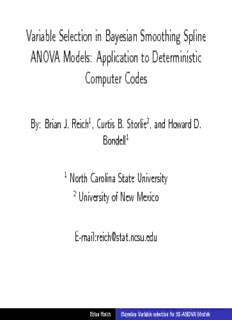Table Of ContentVariable Selection in Bayesian Smoothing Spline
ANOVA Models: Application to Deterministic
Computer Codes
By: Brian J. Reich1, Curtis B. Storlie2, and Howard D.
Bondell1
1 North Carolina State University
2 University of New Mexico
E-mail:[email protected]
BrianReich BayesianVariableselectionforSS-ANOVAModels
Motivation
(cid:73) A common problem for statisticians is a sensitivity analysis of
a complex computer model.
(cid:73) For example, we consider a two-phase fluid flow simulation
study carried out by Sandia National Labs
(cid:73) The computer model simulates the waste panel’s condition
10,000 years after the waste panel has been penetrated by a
drilling intrusion.
(cid:73) The simulation model uses several input variables describing
various environmental conditions.
(cid:73) The objectives are to predict waste pressure for new sets of
environmental conditions and to determine which
environmental factors have the largest effect on the response.
BrianReich BayesianVariableselectionforSS-ANOVAModels
NP regression for complex computer models
(cid:73) Because computer models are governed by complex
differential equations, linear regression is not an adequate
approach for these data.
(cid:73) The standard approach is nonparametric regression:
y = f(x ,...,x )+(cid:178).
1 p
(cid:73) f : Rp → R is an unknown function that relates the
predictors to y’s mean.
(cid:73) Typically f is modeled as a Gaussian process.
(cid:73) (cid:178) ∼ N(0,σ2) is error.
BrianReich BayesianVariableselectionforSS-ANOVAModels
SS-ANOVA models
(cid:73) Modeling f as a Gaussian process is very flexible, but from
this model it can be difficult to identify the effect of an
individual covariate.
(cid:73) When the goal is to identify the effect of each covariate on
the response a more structured model may be preferred.
(cid:73) The smoothing splines ANOVA (SS-ANOVA) model
decomposes the p-dimensional surface f into the sum of
one-dimensional main effect curves main effects f ,
j
two-dimensional interaction curves f , etc.
lk
(cid:88)p (cid:88)
f(x ,...,x ) = β + f (x )+ f (x ,x )+...
1 p 0 j j lk l k
j=1 l<k
(cid:73) Our goal is to develop a computationally efficient method for
selecting important main effects and interactions when p is
fairly large.
BrianReich BayesianVariableselectionforSS-ANOVAModels
Outline
In this talk we will...
(cid:73) Develop a stochastic search variable selection model to
identify important main effect and interaction terms in the
SS-ANOVA framework.
(cid:73) Propose a method for selecting prior to give desirable long-run
properties.
(cid:73) Apply our approach to the Sandia Labs data.
BrianReich BayesianVariableselectionforSS-ANOVAModels
Model for the main effect curves
(cid:73) The regression functions fj is typically restricted to a
particular class of functions.
(cid:73) We consider the subset of Mth-order Sobolev space that
includes only functions that integrate to zero and have M
proper derivatives, i.e., f ∈ F where
j M
F = {g|g,...,g(M−1) are absolutely continuous,
M
(cid:90)
1
g(s)ds = 0,g(M) ∈ L2[0,1]}.
0
(cid:73) We restrict the main effects to integrate to zero to identify
the overall intercept β .
0
(cid:73) We select M = 1 so that draws from the prior are
continuously differentiable with path properties of integrated
Brownian motion.
BrianReich BayesianVariableselectionforSS-ANOVAModels
Prior for f
j
(cid:73) We assume fj is a Gaussian process with E(fj(s)) = 0 and
covariance Cov(f (s),f (t)) =
j j
(cid:34) (cid:35)
(cid:88)2 1
σ2τ2 c B (s)B (t)+ B (|s −t|) ,
j m m m 4! 5
m=1
where c > 0 are known constants and B is the mth
m m
Bernoulli polynomial.
(cid:80)
(cid:73) The first term 2m=1cmBm(s)Bm(t) controls the covariance
of the quadratic trend.
(cid:73) The second term controls the covariance of the deviance from
the quadratic trend.
BrianReich BayesianVariableselectionforSS-ANOVAModels
Prior for f (cont.)
j
(cid:73) Complex models often have categorical variables that
represent different states or point to different submodels to be
used in the analysis.
(cid:73) Assume xj ∈ {1,2,...,G} is categorical and f(xj) = θxj, where
θ i∼id N(0,σ2τ2), g = 1,...,G.
g j
(cid:73) To identify the intercept we enforce the sum-to-zero
(cid:80)
constraint G θ = 0.
g=1 g
(cid:73) This model can also be written in the kernel framework by
taking f to be a mean-zero Gaussian process with singular
covariance
(cid:183) (cid:184)
G −1 1
cov(f(s),f(t)) = σ2τ2 I(s = t)− I(s (cid:54)= t)
j G G
BrianReich BayesianVariableselectionforSS-ANOVAModels
Prior for f (cont.)
j
(cid:73) We take cm = 100 to give a vague prior for the quadratic
trend.
(cid:73) τ2 controls the overall variance, relative to error variance σ2.
j
(cid:73) Interactions are model similarly.
(cid:73) f has mean zero and covariance proportional to σ2τ2
lk lj
(cid:73) f ’s covariance places a vague prior on the second-order
lk
interaction trends.
(cid:73) We do not include higher-order interactions.
(cid:73) Interactions with categorical predictors are handled no
different than other interactions.
BrianReich BayesianVariableselectionforSS-ANOVAModels
Stochastic search variable selection (SSVS)
(cid:73) One way to do variable selection would be to fit all possible
models and pick the one with the smallest AIC, BIC, DIC, etc.
(cid:73) If p = 11 there are 11 main effects, 55 interactions, and 266
possible models.
(cid:73) We use stochastic search variable selection to avoid
enumerating all possible models.
(cid:73) SSVS treats the models as a random variable and uses MCMC
to search for model that fit the data well.
BrianReich BayesianVariableselectionforSS-ANOVAModels
Description:Main effect. P(fj = 0). Anhydrite permeability. 1.00. Borehole permeability. 1.00. Bulk compressibility of brine pocket. 1.00. Halite porosity. 1.00. Microbial degradation of cellulose. 1.00. Residual brine saturation in shaft. 0.66. Halite permeability. 0.46. Permeability of asphalt component of s

